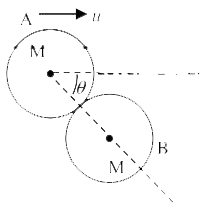For example 32 consider target body B initially at rest, get the expressin for velocities of bodies after the collision (a)m1=m2(b)m2>>m1(c)m2<<m1
To solve the problem of finding the velocities of two bodies after a collision under different mass conditions, we will follow these steps:
Step 1: Understand the Conservation of Momentum
In a collision, the total momentum before the collision is equal to the total momentum after the collision. This can be expressed mathematically as:
m1u1+m2u2=m1v1+m2v2
where:
- m1 and m2 are the masses of the two bodies,
- u1 and u2 are the initial velocities of the bodies,
- v1 and v2 are the final velocities after the collision.
Step 2: Set Initial Conditions
Assume body B is initially at rest, so u2=0. The equation simplifies to:
m1u1=m1v1+m2v2
Step 3: Use the Coefficient of Restitution (if applicable)
In elastic collisions, kinetic energy is also conserved. The equations for the final velocities after the collision can be derived as follows:
1. For body A (mass m1):
v1=m1−m2m1+m2u1
2. For body B (mass m2):
v2=2m1m1+m2u1
Step 4: Analyze the Three Cases
Now, we will analyze three cases based on the relationship between m1 and m2:
Case 1: m1=m2
Let m1=m2=m:
- Substitute into the equations:
v1=m−mm+mu1=0
v2=2mm+mu1=u1
- Conclusion: Body A comes to rest, and body B moves with the initial velocity of body A.
Case 2: m2>m1
Let m2=km1 where k>1:
- Substitute into the equations:
v1=m1−km1m1+km1u1=(1−k)(1+k)u1
v2=2m1m1+km1u1=21+ku1
- Conclusion: Body A rebounds with a negative velocity, and body B moves forward.
Case 3: m2<m1
Let m2=km1 where k<1:
- Substitute into the equations:
v1=m1−km1m1+km1u1=(1−k)(1+k)u1
v2=2m1m1+km1u1=21+ku1
- Conclusion: Body A continues moving forward, and body B moves forward with a greater velocity.
Final Expressions
- For m1=m2: v1=0, v2=u1
- For m2>m1: v1=−u1, v2=0
- For m2<m1: v1=u1, v2=2u1
In a collision, the total momentum before the collision is equal to the total momentum after the collision. This can be expressed mathematically as:
m1u1+m2u2=m1v1+m2v2
where:
- m1 and m2 are the masses of the two bodies,
- u1 and u2 are the initial velocities of the bodies,
- v1 and v2 are the final velocities after the collision.
Assume body B is initially at rest, so u2=0. The equation simplifies to:
m1u1=m1v1+m2v2
In elastic collisions, kinetic energy is also conserved. The equations for the final velocities after the collision can be derived as follows:
1. For body A (mass m1):
v1=m1−m2m1+m2u1
2. For body B (mass m2):
v2=2m1m1+m2u1
Now, we will analyze three cases based on the relationship between m1 and m2:
Let m1=m2=m:
- Substitute into the equations:
v1=m−mm+mu1=0
v2=2mm+mu1=u1
- Conclusion: Body A comes to rest, and body B moves with the initial velocity of body A.
Let m2=km1 where k>1:
- Substitute into the equations:
v1=m1−km1m1+km1u1=(1−k)(1+k)u1
v2=2m1m1+km1u1=21+ku1
- Conclusion: Body A rebounds with a negative velocity, and body B moves forward.
Let m2=km1 where k<1:
- Substitute into the equations:
v1=m1−km1m1+km1u1=(1−k)(1+k)u1
v2=2m1m1+km1u1=21+ku1
- Conclusion: Body A continues moving forward, and body B moves forward with a greater velocity.
- For m1=m2: v1=0, v2=u1
- For m2>m1: v1=−u1, v2=0
- For m2<m1: v1=u1, v2=2u1
Topper's Solved these Questions
- WORK, ENERGY AND POWERBOOK - AAKASH INSTITUTE ENGLISHCHAPTER - WORK, ENERGY AND POWEREXERCISE - SECTION-A (OBJECTIVE TYPE QUESTIONS (ONE OPTIONISCORRECT)
60 Videos
- WORK, ENERGY AND POWERBOOK - AAKASH INSTITUTE ENGLISHCHAPTER - WORK, ENERGY AND POWEREXERCISE - SECTION-B (SUBJECTIVE TYPE QUESTIONS) (ONE OPTIONS IS CORRECT)
45 Videos
- WORK, ENERGY AND POWERBOOK - AAKASH INSTITUTE ENGLISHCHAPTER - WORK, ENERGY AND POWEREXERCISE - IILUSTRATION
2 Videos
- WAVESBOOK - AAKASH INSTITUTE ENGLISHCHAPTER - WAVESEXERCISE - ASSIGNMENT ( SECTION-D ( Assertion - Reason Type Questions ))
12 Videos
Similar Questions
A body of mass m1 moving at a constant speed undergoes an elastic head on collision with a body of mass m2 initially at rest. The ratio of the kinetic energy of mass m1 after the collision to that before the collision is -
View SolutionConsider the elastic collision f two bodies A and B of equal mass. Initially B is at rest and A moves with velocity v. After the collision -
View SolutionA body is projected with an initial Velocity 20 m/s at 60° to the horizontal. Its velocity after 1 sec is
View SolutionParticle A of mass m1 moving with velocity (√3ˆi+ˆj)ms−1 collides with another particle B of mass m2 which is at rest initially. Let →V1and→V2 be the velocities of particles A and B after collision respectively. If m1=2m2 and after collision →V1−(ˆi+√3ˆj)ms−1, the angle between →V1and→V2 is :
View SolutionA body of mass 'm' moving with certain velocity collides with another identical body at rest. If the collision is perfectly elastic and after the collision both the bodies moves
View SolutionA body of mass m moving with a constant velocity collides head on with another stationary body of same mass if the coefficient of restitution between the bodies is 12 then ratio of velocities of two bodies after collision with be
View SolutionA ball A of mass M collides elastically with a similar ball B at rest as shown in figure. Initially velocity of ball A is u m/s. After collision,

View SolutionA body 'A' moving in a straight line with velocity v makes a collision with a body 'B' initially at rest. After collision, B acquires a velocity of 1.6v. Assuming the bodies to be perfectly elastic, what is the ratio of the mass of A to that of B? What percentage of A's energy is transferred to B as a result of collision.
View SolutionA moving body of mass m makes a head on elastic collision with another body of mass 2m which is initially at rest. Find the fraction of kinetic energy lost by the colliding particles after collision.
View SolutionA body of mass a moving with a velocity b strikes a body of mass c and gets embedded into it. The velocity of the systems after collision is
View Solution
